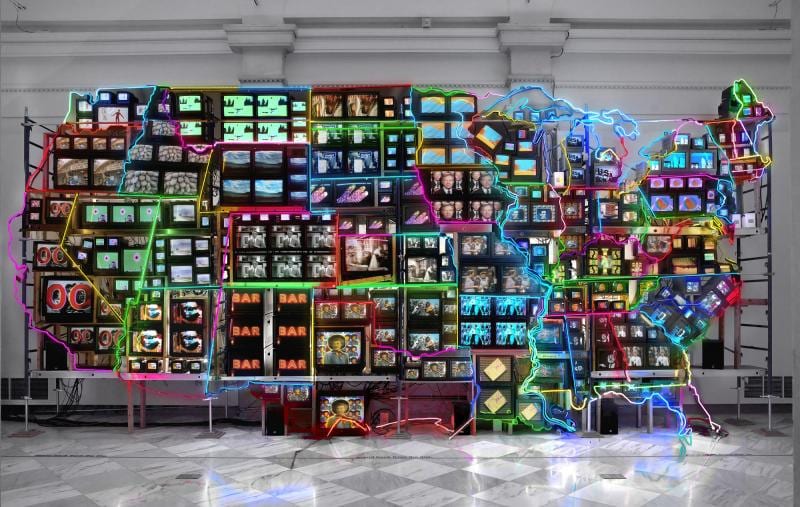Electronic Superhighway
Who is the practitioner (what is their name?) and when were they practicing?
Nam June Paik was a globally recognised video producer, most renowned for his manipulation of the television, recreating perceptions of what the television could do. Paik was considered the “father of video art” and mainly practiced in the 1960s when he joined Fluxus; an international community of artists. Paik produced various types of work including video sculptures, performances and installations (Smithsonian American Art Museum 2009).
What is the title of the photo or video you have chosen to analyse (can you provide a link?)
I have chosen to analyse Paik’s work “Electronic Superhighway: Continental U.S., Alaska, Hawaii”. https://www.youtube.com/watch?v=p16JxNV90SU
With the photo or video, you are examining when was it produced (date)?
This work was produced in 1995 in the U.S.
How was the photo or video authored?
Paik’s Electronic Superhighway predominantly consists of a 51 channel closed circuit video installation, but the work also includes neon lighting and other materials. To be specific, it comprises of 336 televisions, 50 DVD players, 3,750 feet of cable and 575 feet of neon lighting (Li 2019). It is physically divided into the various states of the U.S.A, the cable shaped to represent each state geographically. Paik included looping videos on televisions he believed represented each state. For example, clips from The Wizard of Oz for Kansas.
The video sculpture represents Paik’s perception of the diverse and varied USA, representing cultural and physical aspects of each state. The underlining understanding of each state through the impact of media technology (Smithsonian Museum of American Art 2015). Paik coined the term Electric Superhighway, referring to his prediction that technology would allow for global connectedness (Ryan 2017). This video sculpture is a U.S. specific representation of that prediction.
How was the photo or video published?
This work was produced for the purpose of being art. Paik previously produced the work Electronic Superhighway for the 1993 Venice Biennale (Ryan 2017). This work included a bank of televisions showcasing videos from a variety of sources. In response to this work Paik produced the Electronic Superhighway: Continental U.S., Alaska, Hawaii, derived from his previous work but much more expansive. This work was produced to be not only visually appealing but also to convey a specific message and, as most art does, have various interpretations. In 1967 Paik was commissioned by the Rockefeller Foundation who granted him money to cover cost of living and art materials (Rockefeller Foundation 2019). Therefore he was in a position to produce art for basically whatever purpose he wanted. Assumably, this specific piece was produced with the intention of being displayed in a art gallery or museum as he did in fact gift this work to the Smithsonian American Art Museum.
How was the photo or video distributed?
Electronic Highway is permanently on exhibit at the Smithsonian American Art Museum. This is a very large museum in Washington which displays historical and modern American art. The museum received 2.6 million visits in 2013 (Smithsonian Institution 2014) indicating the large reach Paik’s work has on display there. Additionally, the museum has numerous websites which feature articles on the Electronic Highway: Continental U.S., Alaska, Hawaii such as this article and this one. Having this digital presence allows for greater reach of Paik’s work as people might visit the website and happen to see one of those articles attracting them to visit Paik’s video sculpture at the museum.
REFERENCES
Smithsonian American Art Museum 2015, Electronic Superhighway: Continental U.S., Alaska, Hawaii, viewed 13 April 2019, <https://americanart.si.edu/artwork/electronic-superhighway-continental-us-alaska-hawaii-71478>
Smithsonian Institution, Smithsonian American Art Museum Fact Sheet, 2014, viewed 13 April 2019, <https://www.si.edu/newsdesk/factsheets/smithsonian-american-art-museum>
Smithsonian American Art Museum 2009, Nam June Paik, viewed 13 April 2014, <https://americanart.si.edu/artist/nam-june-paik-3670>
Ryan, T 2017, Nam June Paik, Electronic Superhighway: Continental U.S., Alaska, Hawaii, viewed 13 April 2019, <https://www.khanacademy.org/humanities/ap-art-history/global-contemporary/a/paik-electronic-superhighway>
Li, J 2019, ‘Nam Jun Paik Artist Overview and Analysis’, The Art Story, viewed 13 April 2019, <https://www.theartstory.org/artist-paik-nam-june-artworks.htm>
Rockerfeller Foundation 2019, Our History, viewed 13 April 2019, <https://www.rockefellerfoundation.org/about-us/our-history/>

